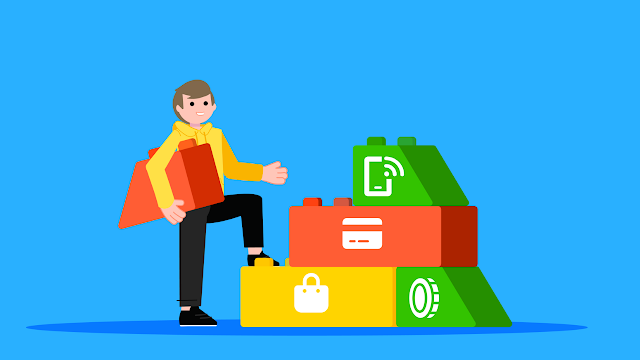How to create a payment gateway?
If you decide to build your own payment gateway software
rather than using one that is already available, keep in mind the following
difficulties. Developing from scratch can benefit a wide range of market
players, from startups looking for a chance to propose payment gateways in an
underserved region to merchants looking for methods to reduce payment service
fees. Those who are solely interested in developing payment method integration
services will benefit from this article.
This guide will aid our audience in creating a simple
payment solution.
What is a
payment gateway?
A payment gateway
functions as a "middleman" between a customer and a vendor. This
program enables online transactions by sending information from the client to
the acquirer and then returning either accepatance or decline to the client.
However, a payment gateway does more than just transfer data.
First and foremost, it ensures that the customer has
sufficient funds on his card (or digital wallet, or other payment method) to
cover the transaction. Then, using encryption, it guarantees complete
protection of any sensitive data processed within the system.
Finally, a payment gateway exists to safeguard the business
from potential fraud. Major credit card companies have set fraud and chargeback
thresholds that are punishable. As a result, payment gateways typically include
fraud and chargeback prevention systems to assist businesses in avoiding
payment fraud.
Why create a
custom gateway?
There are numerous ready-made payment methods that you can
easily integrate into your shop. In the previous piece, we looked at the top
payment gateway providers and provided a credit card processing comparison
chart. However, none of these options will give you complete control over the
payment procedure. Furthermore, there will always be things you want to change
or introduce.
As a result, we chose to share our vision of building a
custom gateway. We discuss the benefits and drawbacks of such an undertaking,
as well as some tricky moments.
Payment supplier
vs. payment gateway
It is critical to grasp the distinction between a payment
gateway and a payment provider. While the first is software, the ability to use
that software for its intended goal is the second.
So, just because you wrote a working program doesn't mean
you can immediately embed it into your website or offer it to other merchants.
First, you must complete the certification procedure and establish a connection
with a payment processor. It should be noted that developing software is not a
difficult job. The licensing process, on the other hand, can take months or
even years. You can only function as a provider after you have obtained all of
the necessary permissions.
How to create a
Payment Gateway?
The exact steps to establish a payment gateway will depend
on the needs of your business, but most businesses will use a process similar
to the one outlined below.
Ideation
Creating an idea for a payment system is only the first step;
you'll still need to consult with experts to see if the plan is viable or needs
to be tweaked.
If you want to create a competitive financial payment
system, you must conduct extensive market study to identify existing
opportunities and areas where your competitors are vulnerable.
Design
It's time to hand over your concepts to the designers now
that they're more cohesive. A staff of experienced UI/UX and graphics designers
can assist you in creating the interface and brand identity for your product.
They can also assist you in developing a functional prototype for use as a
proof of concept. After several iterations, you'll have a viable product design
that developers can begin constructing.
Development
During this time, the fundamental infrastructure of your
payment system will begin to take shape. The material design components from
the prototypes will be collected by the development team and used to code the
product. Developers can also incorporate third-party APIs in accordance with
industry standards, depending on the technical requirements.
Most businesses manage front-end and back-end development
concurrently, while others begin with front-end development before moving on to
the back-end stage. Whatever method you prefer, always use the proper tools to
build a solid system infrastructure for your gateway service.
Quality control
Uncrushed bugs and poor error handling can doom your payment system before it even starts and/or cost you a lot of money afterward. Allow
your QA specialists to rigorously test the software to ensure that everything
is in perfect working order to avoid these additional fees. Following testing,
they should create a comprehensive report for future changes.
Optimization
If the flaws are critical, revisit some of the early stages
of development to close all gaps. Minor faults can be addressed by DevOps teams
to make the payment gateway flawless. Don't neglect about compliance standards
when optimizing the final version.
Product
introduction
You may have time to release the beta version for user input
depending on your timeline. Prepare to debut it as a standalone software
program after making the changes, or offer it as a white-label software
solution to other financial institutions.
Maintenance and
assistance
After the product is released, you must continue to assist
the payment system's users. Create a staff of live support agents to answer
inquiries and resolve conflicts for users. Bots can also answer commonly asked
queries. Your developers should also keep working on updates to keep the
platform operating as smoothly as possible.
Create payment
channel advantages
·
Over time, monthly and per-transaction costs
will be reduced.
·
Complete authority over payment processing, as
well as the ability to develop your own custom features
·
You can earn extra money by selling your payment
portal services to other businesses.
Create a payment
channel disadvantages
·
Significant start-up expenses, including all
necessary certifications, developer fees, and audits
·
Long setup time between development and UX
testing, as well as continuous maintenance
·
More manpower is required than an out-of-the-box
option.
·
Your entire responsibility for security rests on
your shoulders.
Conclusion
Creating a custom feature-rich payment system is a sure way
to establish your business as a trusted name in fintech. Combine brainstorming
with thorough study to determine the type of gateway you want to create, and
then use the tips in this article to fine-tune your product roadmap. Don't
neglect about testing and compliance standards when designing your own gateway.
Make the system scalable and secure enough to handle massive transaction
volumes securely — as essential as any other aspect, if not more so. SSLCOMERZ is country largest payment gateway
in Bangladesh.
This article is originally published on Kagoz.


.png)

Comments
Post a Comment